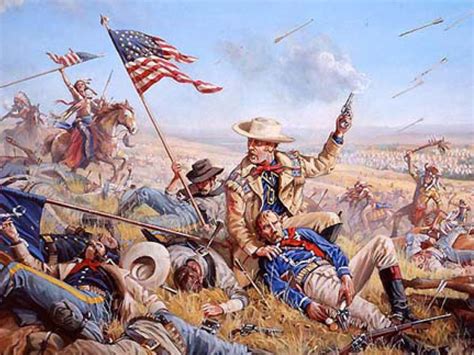Date: June 25-26, 1876
Location: Little Bighorn River, Montana
Significance: Decisive victory for the Lakota Sioux, Cheyenne, and Arapaho against the United States Army’s 7th Cavalry Regiment, led by Lieutenant Colonel George Armstrong Custer.

Background
In the years leading up to the Battle of Little Bighorn, tensions had been escalating between the United States government and the Lakota Sioux, Cheyenne, and Arapaho tribes. The government’s aggressive expansionist policies and the discovery of gold in the Black Hills had led to widespread unrest among the tribes.
In May 1876, the United States Army launched a three-pronged campaign to subdue the rebellious tribes. Colonel John Gibbon’s column moved north from Fort Ellis, Montana, while Brigadier General George Crook’s column advanced west from Fort Laramie, Wyoming. Lieutenant Colonel George Armstrong Custer’s 7th Cavalry Regiment was tasked with sweeping south from Fort Abraham Lincoln, North Dakota, and meeting up with Gibbon’s and Crook’s columns.
The Battle
On June 25, 1876, Custer’s 7th Cavalry Regiment encountered a large encampment of Lakota Sioux, Cheyenne, and Arapaho warriors on the banks of the Little Bighorn River. Custer’s initial plan was to divide his regiment into three columns and attack the encampment from three sides. However, he underestimated the size of the Indian force and the ferocity of their resistance.
The Indians, led by Sitting Bull and Crazy Horse, overwhelmed Custer’s column and drove it back. Custer and his men were killed in the fighting. The rest of the 7th Cavalry Regiment was forced to retreat in disarray.
Casualties
The Battle of Little Bighorn was one of the most disastrous defeats in American military history. The 7th Cavalry Regiment lost 268 men, including Custer himself. The Indian losses were much lower, with an estimated 50-100 warriors killed.
Significance
The Battle of Little Bighorn marked the end of the United States Army’s campaign to defeat the Lakota Sioux, Cheyenne, and Arapaho tribes. The tribes were able to maintain their independence for several more years, but the battle ultimately led to their defeat and the loss of their lands.
The Battle of Little Bighorn also had a profound impact on American society. It helped to galvanize support for the Indian Rights Movement and led to a re-evaluation of the government’s policies toward Native Americans.
Key Figures
- George Armstrong Custer: Lieutenant colonel and commander of the 7th Cavalry Regiment. Killed in action at the Battle of Little Bighorn.
- Sitting Bull: Hunkpapa Lakota medicine man and leader. One of the main leaders of the Indian resistance at Little Bighorn.
- Crazy Horse: Oglala Lakota warrior and leader. One of the main leaders of the Indian resistance at Little Bighorn.
Historical Significance
The Battle of Little Bighorn was a pivotal event in American history. It marked the end of the Indian Wars and the beginning of a new era in relations between the United States and Native Americans. The battle also had a profound impact on American society, helping to galvanize support for the Indian Rights Movement and leading to a re-evaluation of the government’s policies toward Native Americans.
